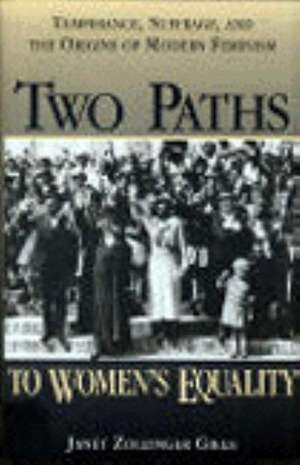Social Movements Past and Present Series: Two Paths to Women's Equality (Cloth): Twayne's Social Movements Past & Present
Autor Janet Zollinger Gieleen Limba Engleză Hardback – 31 dec 1994
Preț: 385.75 lei
Nou
Puncte Express: 579
Preț estimativ în valută:
73.82€ • 76.26$ • 61.44£
73.82€ • 76.26$ • 61.44£
Carte indisponibilă temporar
Doresc să fiu notificat când acest titlu va fi disponibil:
Se trimite...
Preluare comenzi: 021 569.72.76
Specificații
ISBN-13: 9780805797008
ISBN-10: 0805797009
Pagini: 295
Dimensiuni: 146 x 225 x 24 mm
Greutate: 0.48 kg
Ediția:New.
Editura: Twayne Publishers
Seria Twayne's Social Movements Past & Present
ISBN-10: 0805797009
Pagini: 295
Dimensiuni: 146 x 225 x 24 mm
Greutate: 0.48 kg
Ediția:New.
Editura: Twayne Publishers
Seria Twayne's Social Movements Past & Present
Textul de pe ultima copertă
Temperance and Woman Suffrage were about much more than prohibition and the vote; they were powerful early expressions of what has become the continuing concern of the women's movement for the social well-being of children and families and for the right of women to the same opportunities as men. In this first book to assess the combined influence of temperance and suffrage on woman's evolving role in American society, sociologist Janet Zollinger Giele argues that the two movements together accomplished much more than either could have done alone. Giele traces the history of temperance and suffrage to women's involvement in missionary work, moral reform, and abolition between the Revolutionary and Civil Wars. Her intensive study of the Woman's Christian Temperance Union, founded in 1874, reveals what many will find to be its surprisingly wide scope of social concerns. The temperance women, often thought of in caricature as priggish, narrow-minded souls who abhorred alcohol, were largely motivated by the desire to eliminate the ill health, poverty, violence against women and children, and broken homes that resulted from its abuse. Giele's study of the suffrage movement chronicles its evolution from the small gathering in Seneca Falls, New York, in 1848 through the dramatic division of its ranks following the Civil War to its reunification near the turn of the century and finally to its ultimate victory with the passage of the Nineteenth Amendment in 1920. Giele's analysis is informed by her search of the leading temperance and suffrage newspapers for a view of each group's concerns unfiltered by time and second opinions; she also surveys the life histories of dozens of temperance andsuffrage leaders to discern the common experiences that likely led them to their cause. Her study of each movement covers its ideology, organizational development, and tactical strategies. "The temperance and suffrage movements illustrate three important points for modern-day feminists", Giele concludes. "First, the early leaders were inspired by the challenges and difficulties in their own lives to envision the new social order in which they wanted to live. Second, they organized and pressed their agenda for social change until they won a wider following. Finally, they welded their claims on behalf of others together with claims on behalf of themselves. United for social responsibility as well as for individual rights, their cause could not be turned aside". Giele's original research, comprehensive historical knowledge, insightful analysis, and thoughtful application of scholarly theory to real-life practice render this volume useful to practicing feminists and students of feminist and social movement history alike.












